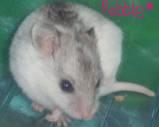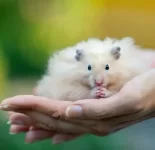Syrian Hamsters
Syrian hamsters were originally just golden hamsters. Over the decades, different colours and patterns have emerged either spontaneously (mutation) or via breeding. There is a huge range of colourings for Syrian Hamsters - more about dwarf hamsters later. This is quite a complex genetic pairing to create certain colours and it is one reason this forum doesn't recommend breeding - other than by an authorised breeder who is a member of a reputable society for breeding - in the Uk, the US or elsewhere. Breeding the wrong colour combinations (and with unknown hidden recessive genes or unknown history) can lead to baby hamsters being born with genetic abnormalities. There are some colours that should never be paired.
Here are some basics and attached below is an article showing different Syrian hamster colourings.
Basics:
Syrian hamsters are either short haired or long haired. Their coats are either satin (shinier) or non satin. Some hamsters have "Rex" (curly) coats.
Regardless of hair length and type they can also come in different colours
When getting a hamster from a pet shop they may look like a cream hamster or a golden hamster or a black hamster but may have hidden genetics (recessive genes) which are unknown and could contraindicate with other colours for pairing.
Colourings are also banded or non banded. (The white band round their middle).
The second article attached, shows the long list of different coat colours and eye colours relating to the coat colours. These articles should help you identify which colour your hamster is.
Common colourings are golden, black, black eyed cream, red eyed cream, cinnamon, grey, sable (the ones with eye rings). Less common colours are chocolate or white. There is a huge variety of colourings though and markings.

Dwarf Hamsters
Winter White Russian Hamsters
Winter white hamsters come in two colours but also with different patterns. The "normal" colour (brown) - sometimes called agouti - and the Sapphire colour (a kind of blue grey colour). They can be solid coloured or have patterns. The name winter white is due to the hamster's coat turning white in winter, in it's natural habitat (camouflage). They have a distinctive dark stripe down their back. They also have furry feet.
Dwarf Campbells Russian hamsters
These can come in various colours from brown to white. The article below lists some of them. They also have a thin dorsal stripe along the back.
Hybrid Dwarf Hamsters
As mentioned in the species article, nearly all dwarf hamsters from pet shops will be hybrid. That is, a hybrid mating of Winter White and Campbells dwarf hamsters - and then mating of hybrid to hybrid. An unfortunate circumstance which has occurred over many years of interbreeding of these species, often by commercial breeders.
They still make wonderful pets. They can look like either a Winter White or a Campbells - or a bit of both. It is highly unlikely they are a true species, rather than a hybrid, unless they come from a breeder with the hamster having a genetic history.
One reason official breeders and breeding organisations are important is to ensure the original dwarf hamster species survives via careful breeding. Hybrid dwarf hamsters can be prone to diabetes.

Chinese Hamsters
Chinese hamsters come in three colours - Normal, Dominant Spot and black-eyed white. There is also a fairly new "Sapphire" colour which is not yet officially recognised in the Uk breeding world. Chinese hamsters are not as commonly found as other species.
Normal and dominant spot chinese hamster colourings on this link
Photo of Sapphire Chinese hamsters here
 lilliput9.wixsite.com
lilliput9.wixsite.com
Black eyed white fairly speaks for itself! It's an all white chinese hamster with black eyes. They are less commonly found. Photo here
Roborovski Dwarf Hamsters
There are officially only three colours of Roborovski I believe. The normal or wild colour (Agouti), the white faced Husky and a blue/black/pied roborovski colour (piebald patches of colour). See the blog below from Doric Hamstery (partway down the page). However there are quite a few different colourways as well and the article on the second link shows the range. The third link from Wikipedia lists the various colours you can find Roborovskis in.



 en.wikipedia.org
en.wikipedia.org
Also please check out our forum and ask members if you're not sure what type or colour your hamster is!
Syrian hamsters were originally just golden hamsters. Over the decades, different colours and patterns have emerged either spontaneously (mutation) or via breeding. There is a huge range of colourings for Syrian Hamsters - more about dwarf hamsters later. This is quite a complex genetic pairing to create certain colours and it is one reason this forum doesn't recommend breeding - other than by an authorised breeder who is a member of a reputable society for breeding - in the Uk, the US or elsewhere. Breeding the wrong colour combinations (and with unknown hidden recessive genes or unknown history) can lead to baby hamsters being born with genetic abnormalities. There are some colours that should never be paired.
Here are some basics and attached below is an article showing different Syrian hamster colourings.
Basics:
Syrian hamsters are either short haired or long haired. Their coats are either satin (shinier) or non satin. Some hamsters have "Rex" (curly) coats.
Regardless of hair length and type they can also come in different colours
When getting a hamster from a pet shop they may look like a cream hamster or a golden hamster or a black hamster but may have hidden genetics (recessive genes) which are unknown and could contraindicate with other colours for pairing.
Colourings are also banded or non banded. (The white band round their middle).
The second article attached, shows the long list of different coat colours and eye colours relating to the coat colours. These articles should help you identify which colour your hamster is.
Common colourings are golden, black, black eyed cream, red eyed cream, cinnamon, grey, sable (the ones with eye rings). Less common colours are chocolate or white. There is a huge variety of colourings though and markings.

Syrian Hamster Varieties
There are five species of hamster, which are as follows: Syrian Chinese Winter White Russian Dwarf Campbells Russian Dwarf Roborovski Dwarf
harveyhams.weebly.com
Dwarf Hamsters
Winter White Russian Hamsters
Winter white hamsters come in two colours but also with different patterns. The "normal" colour (brown) - sometimes called agouti - and the Sapphire colour (a kind of blue grey colour). They can be solid coloured or have patterns. The name winter white is due to the hamster's coat turning white in winter, in it's natural habitat (camouflage). They have a distinctive dark stripe down their back. They also have furry feet.
Dwarf Campbells Russian hamsters
These can come in various colours from brown to white. The article below lists some of them. They also have a thin dorsal stripe along the back.
Hybrid Dwarf Hamsters
As mentioned in the species article, nearly all dwarf hamsters from pet shops will be hybrid. That is, a hybrid mating of Winter White and Campbells dwarf hamsters - and then mating of hybrid to hybrid. An unfortunate circumstance which has occurred over many years of interbreeding of these species, often by commercial breeders.
They still make wonderful pets. They can look like either a Winter White or a Campbells - or a bit of both. It is highly unlikely they are a true species, rather than a hybrid, unless they come from a breeder with the hamster having a genetic history.
One reason official breeders and breeding organisations are important is to ensure the original dwarf hamster species survives via careful breeding. Hybrid dwarf hamsters can be prone to diabetes.

Dwarf Hamster Varieties
There are four species of dwarf hamster, which are as follows: Chinese Roborovski Dwarf Winter White Russian Dwarf Campbells Russian Dwarf
harveyhams.weebly.com
Chinese Hamsters
Chinese hamsters come in three colours - Normal, Dominant Spot and black-eyed white. There is also a fairly new "Sapphire" colour which is not yet officially recognised in the Uk breeding world. Chinese hamsters are not as commonly found as other species.
Normal and dominant spot chinese hamster colourings on this link
Photo of Sapphire Chinese hamsters here
PHOTOS | lilliputhams
Black eyed white fairly speaks for itself! It's an all white chinese hamster with black eyes. They are less commonly found. Photo here
Roborovski Dwarf Hamsters
There are officially only three colours of Roborovski I believe. The normal or wild colour (Agouti), the white faced Husky and a blue/black/pied roborovski colour (piebald patches of colour). See the blog below from Doric Hamstery (partway down the page). However there are quite a few different colourways as well and the article on the second link shows the range. The third link from Wikipedia lists the various colours you can find Roborovskis in.

Roborovski Dwarf Hamster 101: Essential Basics, Care, and Information
The basics of Roborovski dwarf hamster care, from species information to daily care and more!
craftycrookshanks.typepad.com

Roborovski dwarf hamster - Wikipedia
Also please check out our forum and ask members if you're not sure what type or colour your hamster is!


